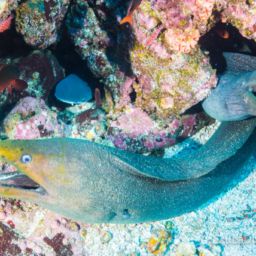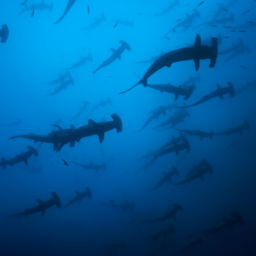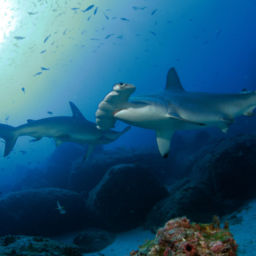As divers, we know that the ocean is home to some magnificent spectacles. Over time, some of them have become legend, immortalized by iconic images. One such image is that of thousands of scalloped hammerheads, their distinctive silhouettes tattooed against a rich background of endless blue. For many divers, the splendor of schooling hammerheads like these is the holy grail of underwater spectacles. Once, they were not such a rare sight. But the relentless targeting of these sharks by the finning industry has pushed them to the brink of extinction.
The IUCN Red List lists hammerheads as endangered. There remain just a handful of places in the world where divers can still see them in their natural environment. Of these, the most famous is a tiny volcanic Cocos Island, 340 miles off the western coast of Costa Rica. Accessible only by liveaboard, Cocos Island is a UNESCO World Heritage site. In 1994, Jacques Cousteau called it “the most beautiful island in the world.”
Diving Cocos Island
A marine park since 1978, Cocos Island is a significant center of biodiversity, on land and underwater. The adventure begins before you get there, via a 36-hour boat trip to the island. Its productive waters are home to at least 27 endemic fish species. Impressive shoals of large game fish, including tuna and trevally, represent a level of productivity seen in few other places on Earth. Cocos is most famous for its sharks. Divers regularly see Galapagos, tiger, silvertip, whitetip, silky and whale sharks. One sight above all others draws divers here, though — the schooling hammerheads that define the island’s diving.
The hammerheads’ congregate at dive sites such as Baja Alcyone, Dirty Rock and Punta Maria, where Cocos’ underwater topography creates the perfect conditions for the sharks. The island drops away steeply into deep water, the depths punctured occasionally by dizzying submarine pinnacles. Perennially strong currents keep the visibility clear and help create upwellings of nutrient-rich water around these pinnacles; it’s here that divers can see the hammerheads, not singly or in pairs, but in the thousands.
Seeing the hammerheads
The hammerheads come to the Cocos Island pinnacles to feed, socialize and visit the cleaning stations at dive sites like Dirty Rock. Because of the strong currents, divers access most of the pinnacles via a shot line to keep them on target. The top of the pinnacle ridge is over 100 feet (30 m) deep and bathed in blue. This is frontier diving, in a place so untouched it’s easy to forget that elsewhere in the world fish are disappearing from the oceans and reefs are being destroyed. When the hammerheads don’t appear, there are plenty of other sights, from winged squadrons of spotted eagle rays, to a silvered Galapagos shark cruising in the blue or a swirling, pulsating shoal of trevally suspended cloud-like over the reef.
When the hammerheads do come out to play, all other distractions fade away. When you see them from below, the school seems to be made up of sharks upon sharks. It’s that iconic image come to life, and in that moment it is hard to imagine anything more magnificent.
When to visit
The faint-hearted or the inexperienced diver should plan a trip elsewhere. Strong currents, plunging depths and lots of sharks make for intense dives. Visitors should have plenty of underwater experience. Because of the depths, divers must have completed a Deep Diver course in addition to their Open Water.
You can see hammerheads year-round, although they occur in greater numbers during the Costa Rican wet season, which runs from June to October. The wet season typically coincides with rougher seas, which can affect visibility. Hammerheads favor this time of year, however, for the elevated level of nutrients, which in turn attract prey fish. You can see the hammerheads from November to May, when drier weather means calmer seas and better visibility. Whenever you choose to visit Cocos, one thing is for certain. You’ll never forget the thrill of witnessing one of nature’s greatest spectacles.




